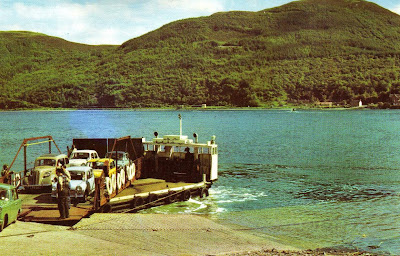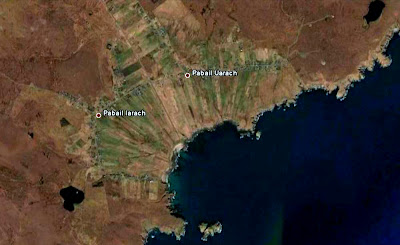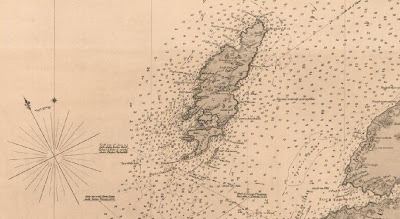Picking up the story from Part 5, in the years after the First World War (1914-18) when motoring began to take off, the car ferry across Loch Carron developed firstly by becoming itself motor powered and secondly by the addition of a method of embarking vehicles more convenient than a pair of long planks of wood.
This was the turntable which, once the vehicle was aboard, could be swung round and stowed lengthwise along the boat's main axis while on passage. As well as avoiding the payload sitting awkwardly athwart-ships as on the "plank-loading" ferries, the main advantage was that, as the turntable could be swung though 360 degrees, the car could drive off "ahead" even when, as was the case at the Strome Ferry, the slipways at both sides only allowed the boat to berth port (left) side to: without the turntable, the car had to reverse off or else the boat had to reverse in at the other side. Turntable ferries became the norm at most short vehicular ferries on the west coast of Scotland in the 1920s.
Now I don't know the exact history of the sequence of the various vessels on the Strome Ferry over the years (if anyone does, please leave a comment) but the next development - in the late 1930s I'd guess - from a single vehicle turntable ferry as pictured above was a two vehicle ferry as seen below at the north terminus in a mid 1950s view:-
Note how the crew appear to be dressed in shorts and stockings and peaked caps. I bet they only dressed like this for the J Arthur Dixon photographer and it was boiler suits and bunnets every other day of the year!
Picture credit Rob Beale
Perhaps the stockings and peaked caps were to mollify angry MPs. Sir William Anstruther-Gray, member for Lanarkshire North, mentioned in the House of Commons in 1937 being stranded on the ferry with his car for three hours. It seemed that, having got the car on board, the state of the tide was such that it could not be disembarked again at either side for three hours. It's unclear from the parliamentary report whether the difficulty was due to the tide being too high or too low but either could pose a problem - at a very low tide, the water is too shallow for the ferry to get alongside but at a very high tide, the slipway simply disappears under the water. Whichever, the issue was dealt with by the slipways at both sides being raised and extended in concrete in the late 1950s (note that in the pictures above, the slipways are still the original stone before this improvement).
The final generation of car ferry at Strome arrived in 1959, this being the Strome Castle, a six car turntable ferry built by Forbes' of Sandhaven, just east of Fraserburgh pictured below at Stromeferry:-
But improved piers and a bigger ferry were not enough to prevent continued questions in the House. In June 1960, the Independent MP for Ross & Cromarty, John MacLeod, in whose constituency the ferry lay, rose to ask the Secretary of State for Scotland if he was aware that there had recently been an instance of people having to wait three hours for the ferry in a queue of 42 cars and when the Government proposed to build a road round the south side of Loch Carron? The minister was typically non-committal and replied by pointing out that such delays were exceptional and highlighting the recent improvement in the ferry service with the deployment of the six car Strome Castle.
In 1962, another six car turntable ferry, the Pride of Strome, built by Nobles of Fraserburgh, was introduced:-
But by now the question was no longer "if" but "when" a by-pass road would be built and the Government eventually approved the funding in October 1965. But it was not for another five years, in October 1970, that the road round the south shore of Loch Carron was finally opened and the ferry closed.
This time, however, the village not only ceased to be a terminus as had happened when the railway was continued to Kyle of Lochalsh in 1897 but it was totally by-passed and left as a dead end as the new road passed by up the hill-side and giving rise to that famous "Strome Ferry - No Ferry" sign.
My own memories of the ferry are that, in the late 60s, we used to go on family holidays to Kishorn just north of Loch Carron and the journey always involved crossing the Strome Ferry (unless we were travelling on a Sunday when the ferry didn't operate so we went round via Inverness instead: in the days before the new A9, that involved a considerable extra distance.)
Although I was only 6 or 7 at the time, I remember the ferry well. I distinctly recall the sound of its diesel engine as it swept up to the slipway and the helmsman abruptly put it into full astern to bring it to a halt, expertly kissing the pier, the water white with foam - water being churned by a ship's propellor was a source of great fascination to me at that age. Another crewman was poised to step ashore with a rope with a metal hook on the end which was inserted in a hole on a metal strap down the centre of the slipway. The mooring rope was either run out from the stern of the ferry and the hook put in a hole forward and the engine left running astern to keep the boat against the pier while loading (as in the picture below of the 1959 Strome Castle) or vice versa (rope from bow and engine left running ahead).
I'm guessing it depended on the state of the tide and how much of the slip there was above water to berth alongside but either option produced lots of churning water for my youthful delectation.
Then after the cars were all aboard (bearing in mind that, at low season, that could be a wait of 20 minutes or so waiting for four or five cars to appear if not necessarily the full compliment of six), the engine was momentarily relaxed to give a bit of slack to release the hook. Then a big burst astern to pull the ferry away from the pier and cut back to neutral as it was turned round to face the other side. Then full ahead again for a passage of just three or four minutes before the engine was cut for a moment and full astern for the whole process to begin again at the opposite terminus.
Picture credit Anne Burgess
I remember one occasion arriving late at the south terminus at Stromeferry and the last ferry had gone for the night. But my father could see movement on the pier at the other side so flashed the headlights of the car in an attempt to encourage the ferry to come back over to collect us. But no joy and we slept in the car till the next morning - a great treat when you're aged 7 but a bit of a chore otherwise. But in 1969 you just put up with these things ...


















































